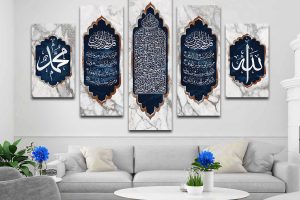Sacred Beauty: Exploring the World of Islamic Wall Art

Islamic wall art stands as a testament to the rich cultural and spiritual heritage of the Islamic world. Beyond mere decoration, it is an expression of faith, creativity, and community that transcends time and geography.
- Sacred Beauty: Exploring the World of Islamic Wall Art
- The Significance of Islamic Wall Art
- A Brief History of Islamic Wall Art
- Origins and Development
- Styles and Techniques of Islamic Wall Art
- Calligraphy in Islamic Wall Art
- Geometric Designs in Islamic Wall Art
- Symbolism in Islamic Wall Art
- Spiritual Significance
- Unity and Community
- Famous Examples of Islamic Wall Art Around the World
- The Alhambra in Spain
- The Sheikh Zayed Grand Mosque in Abu Dhabi
- The Process of Creating Islamic Wall Art
- Traditional Techniques
- Materials Used
- The Impact of Islamic Wall Art on Culture and Society
- Cultural Preservation
- Social Cohesion
- Contemporary Trends in Islamic Wall Art
- Modern Interpretations
- Global Fusion
- Preservation and Conservation of Islamic Wall Art
- Challenges to Preservation
- Conservation Efforts
- Exploring the Spiritual and Aesthetic Values of Islamic Wall Art
- Spiritual Values
- Aesthetic Values
The Significance of Islamic Wall Art
Wall art in Islamic culture isn’t just about aesthetics; it plays a crucial role in conveying messages, reinforcing beliefs, and enhancing the ambiance of both public and private spaces. Artists weave intricate designs and symbols that reflect the values and ideals of Islam, creating pieces that foster a sense of connection among viewers.
- Cultural Expression: Islamic wall art represents various cultures, reflecting local traditions while adhering to Islamic principles.
- Spiritual Reflection: Many works are infused with religious meaning, inviting contemplation and deepening one’s faith.
- Community Building: Artworks often adorn mosques and public spaces, serving as focal points for communal gatherings.
Through generations, these artworks have inspired countless individuals, echoing the profound relationship between faith and creativity. Whether you encounter a delicate calligraphy piece in a bustling market or a grand mural in an ancient mosque, each encounter offers a unique narrative waiting to be discovered.
A Brief History of Islamic Wall Art
As we delve deeper into Islamic wall art, it’s essential to appreciate its historical context. The evolution of this unique art form reflects a rich tapestry of cultural influences and social changes over centuries.
Origins and Development
Islamic wall art dates back to the early periods of Islamic civilization, around the 7th century, flourishing as the religion expanded across diverse regions.
- Early Influences: The early Muslims borrowed artistic traditions from Persian, Byzantine, and Roman cultures, integrating these elements into their unique style.
- The Golden Age: The 8th to 14th centuries marked the Islamic Golden Age, where art and architecture flourished. Cities like Baghdad and Cordoba became hubs for artistic expression, with walls adorned in intricate mosaics and geometric patterns.
As people traveled the Silk Road and beyond, Islamic motifs adapted, reflecting local cultures while maintaining core Islamic tenets. This fluidity brings a personal anecdote to mind: visiting an ancient mosque in Istanbul, seeing how local artisans expressed their heritage through ornate tiles was a mesmerizing experience. Each artwork told a story, bridging the past with the present, showcasing the beautifully intertwined legacy of Islamic wall art throughout history.
Styles and Techniques of Islamic Wall Art
Building upon the rich historical context, let’s delve into the distinct styles and techniques that define Islamic wall art. Two of the most prominent forms are calligraphy and geometric designs, each showcasing unparalleled artistry and spiritual significance.
Calligraphy in Islamic Wall Art
Calligraphy is often regarded as the highest form of art in Islamic culture. It is more than just beautiful writing; it’s a manifestation of divine beauty.
- Spiritual Meaning: Many calligraphic works feature verses from the Quran or Hadith, inviting viewers to reflect on their faith.
- Styles: Different calligraphic styles, such as Thuluth and Naskh, each have unique characteristics and historical significance.
During a recent visit to a mosque, I was captivated by the way the swirling scripts adorned the walls, transforming ordinary spaces into heavenly realms of spirituality.
Geometric Designs in Islamic Wall Art
In addition to calligraphy, geometric designs play a vital role in Islamic art. These intricate patterns symbolize the perfection and order of the universe.
- Characteristics: Often composed of interlocking shapes, these designs exhibit an infinite variety of patterns that can mesmerize the eye.
- Symbolism: The repetition and symmetry in geometric patterns convey the idea of unity and the oneness of God.
The moment I stumbled upon a wall embellished with stunning geometric designs in a historical palace, it felt like stepping into a mathematical dream—a perfect blend of art and mathematics encapsulated in timeless beauty. Both calligraphy and geometric designs make Islamic wall art a fascinating realm where spirituality and creativity converge.
Symbolism in Islamic Wall Art
Continuing our exploration of Islamic wall art, it’s fascinating to consider the layers of symbolism embedded within these pieces. Each design element is carefully chosen to convey deeper meanings that resonate with Islamic beliefs and cultural values.
Spiritual Significance
Islamic wall art often incorporates symbols that reflect the essence of faith and spirituality.
- The Five Pillars: Many designs subtly reference the Five Pillars of Islam, reminding viewers of their spiritual duties.
- Nature Motifs: Elements like flowers and vines are frequently used, symbolizing growth, renewal, and the beauty of Allah’s creation.
During a visit to a stunning mosque in Morocco, I noticed how the intricate floral motifs around the windows brought a sense of tranquility and connection to nature, enveloping the space in peaceful energy.
Unity and Community
In addition to spiritual themes, symbolism in Islamic art often emphasizes unity and community.
- Interconnected Patterns: The intricate geometric designs represent the unity of the Muslim community, illustrating how individual pieces can come together to form a cohesive whole.
- Circular Designs: Frequently used, circular motifs symbolize eternity and the infinite nature of Allah.
Witnessing a massive mural showcasing these interconnected patterns in a community center highlighted how art can inspire collaboration and a sense of belonging among people. In essence, the symbolism in Islamic wall art serves as a bridge between the spiritual realm and shared cultural identity, creating an enriching experience for all who encounter it.
Famous Examples of Islamic Wall Art Around the World
As we appreciate the symbolism behind Islamic wall art, let’s take a journey around the globe to explore some of the most famous examples that showcase this art form’s beauty and diversity.
The Alhambra in Spain
The Alhambra, a stunning palace and fortress complex in Granada, is renowned for its breathtaking Islamic wall art.
- Intricate Tile Work: The tiles feature stunning geometric patterns and calligraphy that reflect the intricate artistry of the Nasrid dynasty.
- Historical Significance: Visiting the Alhambra provides a window into the cultural blending of Islamic and Spanish influences.
I vividly remember standing in the Court of the Lions, feeling as though I was surrounded by history and artistry that transcended time.
The Sheikh Zayed Grand Mosque in Abu Dhabi
Another magnificent example is the Sheikh Zayed Grand Mosque, which boasts some of the most intricate Islamic wall art in the world.
- Marble Inlay: The mosque’s walls are adorned with beautiful inlays made of various colored marbles, depicting floral and geometric designs.
- Calligraphic Elegance: Large calligraphic verses from the Quran beautifully complement the architecture, creating a serene atmosphere.
Walking through its vast prayer halls filled with intricate decorations was a spiritually uplifting experience, reminding me of the deep connection between faith and artistic expression. These examples illustrate how Islamic wall art not only enhances the aesthetic of a space but also weaves together history, culture, and spirituality across different regions.
The Process of Creating Islamic Wall Art
Having explored the stunning examples of Islamic wall art, it’s intriguing to delve into the intricate process behind their creation. Crafting these masterpieces is a labor-intensive journey that requires skill, patience, and a deep appreciation for tradition.
Traditional Techniques
The creation of Islamic wall art often employs various traditional techniques, each contributing to the final piece’s beauty and meaning.
- Calligraphy: Artists begin by sketching intricate designs, often using reed pens and natural inks to maintain authenticity.
- Geometric Patterns: Craftsmen meticulously draw patterns using compasses and straightedges, reflecting the mathematical precision that characterizes Islamic art.
One time, while observing a master calligrapher at work, I was in awe of how each stroke seemed infused with care and purpose, transforming ink into dynamic art.
Materials Used
The choice of materials also plays a crucial role in the artistry.
- Tiles and Mosaics: Colorful ceramic tiles are cut and laid to form stunning mosaics, a hallmark of Islamic architecture.
- Natural Pigments: Artisans often use natural pigments for painting, ensuring vibrant colors that age beautifully over time.
Creating Islamic wall art is not just about aesthetic appeal; it’s a spiritual practice that connects artists to their heritage, inviting viewers to appreciate the meticulous craftsmanship that brings these artworks to life. Each piece tells a story of devotion, culture, and artistry that enriches the spaces they inhabit.
The Impact of Islamic Wall Art on Culture and Society
As we reflect on the intricate process of creating Islamic wall art, it’s essential to consider its profound impact on culture and society. This art form is more than just decoration; it plays a significant role in shaping and expressing collective identity.
Cultural Preservation
Islamic wall art serves as a vital link to historical and cultural heritage, preserving traditions that have been passed down through generations.
- Education: Many artworks incorporate historical narratives and teachings, providing a visual history lesson for future generations.
- Local Identity: Artists often infuse local elements, connecting community members to their unique cultural roots.
During a visit to a cultural exhibition, I was struck by how local artisans showcased their heritage through vibrant wall art, reminding me of the stories that bind communities together.
Social Cohesion
Furthermore, these artworks foster a sense of belonging and community.
- Shared Spaces: Public installations and mosque decorations encourage gatherings, creating a sense of unity among worshippers and community members.
- Cultural Events: Art is often incorporated into festivals and celebrations, strengthening social bonds through shared appreciation.
The powerful impact of Islamic wall art extends beyond aesthetics; it nurtures cultural pride, community solidarity, and a shared spiritual identity that resonates within society.
Contemporary Trends in Islamic Wall Art
As we recognize the impact of Islamic wall art on culture and society, it’s exciting to explore the contemporary trends shaping this vibrant art form today. Artists and artisans are seamlessly blending tradition with modernity, creating innovative pieces that resonate with both young and old.
Modern Interpretations
Contemporary Islamic wall art often embraces experimentation with styles and materials.
- Mixed Media: Artists are incorporating materials like metal, glass, and textiles, leading to dynamic, multi-dimensional pieces.
- Digital Art: With the rise of technology, many artists are utilizing digital platforms to create and disseminate their works, making art more accessible than ever.
I remember visiting a gallery where the fusion of traditional calligraphy with abstract designs was mesmerizing. Each piece told a story, drawing viewers in and opening up dialogues about tradition and innovation.
Global Fusion
Additionally, there is a growing trend towards global influences in Islamic wall art.
- Cross-Cultural Collaborations: Artists are collaborating with peers from various backgrounds, resulting in unique artworks that reflect a blend of cultural aesthetics.
- Urban Art: Street art is making waves in Islamic contexts, with murals adorning cityscapes, inviting urban audiences to engage with traditional themes in fresh, imaginative ways.
These contemporary trends showcase how Islamic wall art continues to evolve, maintaining its relevance while celebrating cultural heritage in innovative ways that inspire new generations.
Preservation and Conservation of Islamic Wall Art
As we celebrate contemporary trends in Islamic wall art, it’s crucial to spotlight the ongoing efforts in preservation and conservation. Protecting these masterpieces ensures that future generations can appreciate the rich craftsmanship and cultural significance they embody.
Challenges to Preservation
Islamic wall art faces various challenges, including environmental factors, urban development, and neglect.
- Environmental Damage: Humidity, pollution, and natural wear can erode intricate designs, compromising the integrity of the artwork.
- Urbanization: Rapid development often puts historical sites at risk, threatening the existence of these precious cultural artifacts.
I recall visiting a restored historical site where artisans worked diligently to restore the ornate tile work. It was heartening to see how dedicated professionals preserved the beauty and history of the art form.
Conservation Efforts
Various initiatives are underway to safeguard Islamic wall art.
- Restoration Projects: Cultural heritage organizations are investing in restoration efforts that adhere to traditional techniques to ensure authenticity.
- Educational Programs: Workshops and training programs for young artisans promote skills that are vital for preserving traditional practices.
Through these concerted efforts, the legacy of Islamic wall art can endure, allowing its timeless beauty and significance to continue inspiring and educating future generations. The collaborative spirit of preservation illustrates how each community can play a part in honoring and maintaining their artistic heritage.
Exploring the Spiritual and Aesthetic Values of Islamic Wall Art
Having discussed the preservation efforts for Islamic wall art, it’s enlightening to reflect on the spiritual and aesthetic values these artworks embody. Striking a balance between the two, Islamic wall art offers a unique lens through which to view faith, beauty, and community.
Spiritual Values
Islamic wall art is deeply embedded with spiritual meaning, encouraging reflection and devotion among viewers.
- Connection to Faith: Many pieces feature verses from the Quran, serving as constant reminders of God’s presence and teachings.
- Sacred Spaces: Art transforms spaces like mosques and prayer halls, fostering an atmosphere conducive to contemplation and connection with the divine.
During my visit to a mosque adorned with radiant calligraphy, I felt enveloped by an energetic peace, as if the art itself was inviting me to reflect on my own journey.
Aesthetic Values
In addition to their spiritual significance, these artworks are masterfully crafted, showcasing exceptional aesthetic value.
- Intricate Designs: The detailed patterns and vibrant colors captivate the eye, often leaving viewers in awe of the artists’ skill.
- Cultural Identity: Every style reflects the unique heritage of its region, allowing audiences to appreciate the diversity within Islamic art.
The interplay of spiritual and aesthetic values in Islamic wall art not only elevates its beauty but also emphasizes its purpose as a vehicle of cultural expression and devotion. This duality enriches our understanding, drawing us closer to both the art form and the beliefs it represents.





